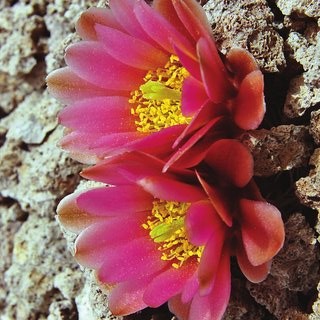Fishhook cactus
(Sclerocactus polyancistrus)

Description
Sclerocactus polyancistrus is a species of cactus that is native to the southwestern United States and northern Mexico. Also known as the fishhook cactus or desert fishhook cactus, this plant is a popular choice among collectors and horticulturists due to its unique appearance and adaptability to various growing conditions. In this article, we will explore the various features and characteristics of the Sclerocactus polyancistrus. Taxonomy and Classification The Sclerocactus polyancistrus belongs to the Cactaceae family and is classified under the genus Sclerocactus. The plant was first described by American botanist Nathaniel Britton in 1909. The species name polyancistrus is derived from two Greek words, "poly" meaning "many," and "ankistron" meaning "hook," referring to the many hooked spines that adorn the cactus. Physical Description The Sclerocactus polyancistrus is a small, globular cactus that grows to a height of up to 6 inches (15 cm) and a diameter of up to 4 inches (10 cm). It has a thick, fleshy stem that is covered with clusters of spines that range in color from yellow to brown. The spines are hooked, giving the plant its characteristic fishhook appearance. The cactus produces small, pale yellow flowers that bloom in spring and summer, followed by small fruits that contain black seeds. Habitat and Distribution The Sclerocactus polyancistrus is native to the southwestern United States and northern Mexico. It can be found in desert areas, rocky slopes, and sandy soil at elevations ranging from 2,500 to 5,000 feet (762 to 1524 meters). The cactus is adapted to arid and semiarid climates and can tolerate extreme temperatures ranging from 20°F (-7°C) to 110°F (43°C). It is also drought-tolerant and can survive long periods without water. Cultivation and Propagation The Sclerocactus polyancistrus is a popular choice among collectors and horticulturists due to its unique appearance and adaptability to various growing conditions. The cactus can be grown both indoors and outdoors, as long as it is provided with well-draining soil and plenty of sunlight. It is also drought-tolerant and does not require frequent watering. Propagation of the Sclerocactus polyancistrus can be achieved through seed germination or by rooting stem cuttings. Seeds should be sown in well-draining soil and kept moist until germination. Stem cuttings should be taken in early spring and left to dry for a few days before being planted in well-draining soil. Uses The Sclerocactus polyancistrus has limited practical uses, but it is highly valued among cactus enthusiasts and collectors for its unique appearance and adaptability to various growing conditions. As a native plant to arid regions, it plays an important ecological role in its natural habitat, serving as a source of food and shelter for various desert animals, including birds and rodents. Additionally, as with all plant species, Sclerocactus polyancistrus contributes to the overall biodiversity of the desert ecosystem. However, it should be noted that the illegal collection of this species for ornamental purposes has led to a decline in wild populations, highlighting the importance of conserving and protecting this species in its natural habitat. Conservation Status The Sclerocactus polyancistrus is listed as a species of "Least Concern" by the International Union for Conservation of Nature (IUCN). However, the cactus is threatened by habitat loss due to urbanization, agriculture, and mining activities. It is also collected illegally for ornamental purposes, which has led to a decline in wild populations. To protect the Sclerocactus polyancistrus, it is important to enforce laws against illegal collection and protect its natural habitat. Conclusion Sclerocactus polyancistrus is a unique and fascinating plant that is well-suited to arid and semiarid environments. Its adaptability to various growing conditions and drought tolerance make it a popular choice among collectors and horticulturists. However, its wild populations are threatened by habitat loss and illegal collection, making conservation efforts essential to ensure its survival.
Taxonomic tree:







